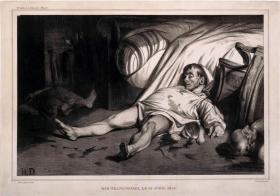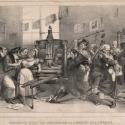Laughton, Bruce. Honoré Daumier. New Haven, CT: Yale University Press, 1996
Honoré Daumier
Died: Valmondois, 10 February 1879
Nationality: French
son of a glazier, frame-maker, and picture restorer
with Alexandre Lenoir; Académie Suisse (Paris)
1829 – publishes first lithograph, in La Silhouette
1830 – contributes cartoons and caricatures to new, anti-monarchist journal La Caricature (published by Gabriel Aubert and Charles Philippon)
1832 – Aubert and Philppon found Le Charivari; Daumier contributes cartoons and caricatures and is imprisoned for six months because of Gargantua, published in La Caricature (15 December 1831); begins making caricature sculptures of political figures
1834 –begins painting
1835 - increased censorship forces Le Charivari to focus on everyday subjects; Daumier contributes circa 4,000 caricatures
1849-51 – exhibits Miller, his Son and the Ass (Art Gallery, Glasgow), Two Nymphs Pursued by Satyrs (Museum of Fine Arts, Montreal), Don Quixote Going to the Wedding of Gamaches (private collection) at Paris Salon
1860 – quits Le Charivari
1862 – works as illustrator for Le Boulevard, founded by Etienne Carjat
1863 – resumes work for Le Charivari
1878 – friends mount unsuccessful exhibition of Daumier’s work to raise money for the impoverished artist
Gargantua, 1832 (Le Charivari; caricature of Louis-Philippe, King of France)
Ratapoil, c. 1851(Musée d'Orsay, Paris; caricatural sculpture of Napoleon III)
The Third-Class Carriage, c. 1862-64 (Metropolitan Museum of Art, New York)
In his old age, Daumier was desperately poor, but friends tried to help him out:
“On the one hand, on 27 January 1878 a group of close friends, distressed at the old caricaturist’s poverty, met in the atelier of Karl Daubigny, set themselves up as a Comité d’organisation and hired galleries from Durand-Ruel for the period 15 April to 15 June. An address list of owners of Daumier’s lithographs, drawings and paintings was drawn up. Victor Hugo* was invited to become Président d’honneur, a role he accepted….The exhibition was a failure. Though the Comité d’organisation met every Friday at the exhibition itself and wrote a number of articles, the receipts amounted to only 3,190 francs against an expenditure of 12,700 francs…
What was on show in the exhibition? Paintings, above all, together with drawings, and finally assembled as number 244 at the end of the catalogue under the rubric ‘Divers’ (miscellaneous)…[‘twenty-five matted lithographs by] Daumier. Hierarchy had been re-established; once again, order reigned in the arts. As a critic remarked on the occasion of one of the many subsequent Daumier exhibitions organized on the same lines as the first, with such priorities Ingres [who played violin a lot as an elderly man] would have to be considered first and foremost as a violinist.”
*Victor Hugo (1802-85) was, by 1878, France’s most famous and beloved writer. He wrote Les Miserables (1862) and The Hunchback of Notre Dame (1831). Hugo was also an artist and political activist.
Michel Melot and Neil McWilliam, “Daumier and Art History: Aesthetic Judgment/Political Judgment,” Oxford Art Journal, vol. 11, no. 1 (1988): 4-5.




 Buy the Book
Buy the Book